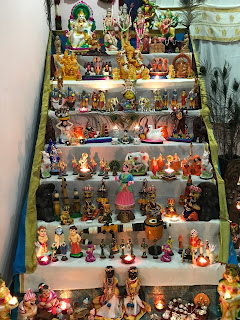Significance of Bommala Koluvu
Festivals are auspicious occasions to celebrate our well being. They spread in tranquility and are the right times to rejoice from our daily tumults.
The sacred Navrathri (Nine Nights), which are celebrated to symbolize the victory of good over the evil came to an end and so do the fun filled doll arrangements, the "BOMMALA KOLUVU", which is carried over to us from our ancestors.
 To all those who are unfamiliar, it is a tradition where a collection of clay and wood idols of gods and goddess are displayed, which is carried over from one generation to other along with a new add-on every year.
To all those who are unfamiliar, it is a tradition where a collection of clay and wood idols of gods and goddess are displayed, which is carried over from one generation to other along with a new add-on every year.
What exactly is this Golu/ Bommala koluvu???
 To all those who are unfamiliar, it is a tradition where a collection of clay and wood idols of gods and goddess are displayed, which is carried over from one generation to other along with a new add-on every year.
To all those who are unfamiliar, it is a tradition where a collection of clay and wood idols of gods and goddess are displayed, which is carried over from one generation to other along with a new add-on every year.
Since my childhood, this festival conjures to me a special feast of celebration as it truly kindles the artistic flair buried deep inside us. The whole year we find our tradition coupled with our excitement locked safely in trunks and carton boxes arranged over the attics awaiting for the commencement of a feast of toys.
I still remember almost every Dasara I had at my mom's place. But this one remains to be a bit more memorable as Samyu, my little baby doll, is involved in arranging these doll deities.
To mark this, I felt like making a post all about this celebration and the reason behind arranging our "gudia darbar."
To mark this, I felt like making a post all about this celebration and the reason behind arranging our "gudia darbar."
Golu to me means...
Bommala Koluvu, the court of toys, is a beautiful arrangement of diverse dolls. Golu is quite familiar among the South Indians but the reason behind the doll arrangement is not known to many of us. I heard multiple reasons for the doll arrangements and here are a few from my understanding.- The arrangement of Golu signifies and explains the evolution of human race.
- The number of steps often seen are in a odd count i.e., from 3 to 9 steps, with a ceremonial jar (kalasa) arranged on top of the kolu padi (steps).
- 3 step arrangement explains the classification of human race on the basis of their VIRTUES (satva, rajo and the tamo gunas), 5 steps for the 5 elements, the sky, water, fire, land and the air, 7 the Seven divine mothers (Sapta Matrikaas) from the Hindu mythology and 9 the Navarathri.
- First series of steps: All the idols of gods and goddesses are placed on these steps along with the kalasa, the ceremonial jar.
- Second series of steps: Forms of gods and their reincarnations are arranged in the second series of steps. Idols of noble kings are also placed on these rows.
- In general segments of importance from mythology and history, marriage procedures and processions, village cultures and traditions, day to day chores in villages, agricultural practices, harvest seasons etc. can be depicted in this doll festival.

- A lamp is lit every day from the day one and on the tenth day a doll is kept to sleep and the Kalasa is slightly moved towards the north, which technically means the end of Navarthari for this year.
- But to me it is like the little dolls saying that we rest for the year and will hopefully see you the next year with more grace!!!










Plz send bommala shop
ReplyDelete